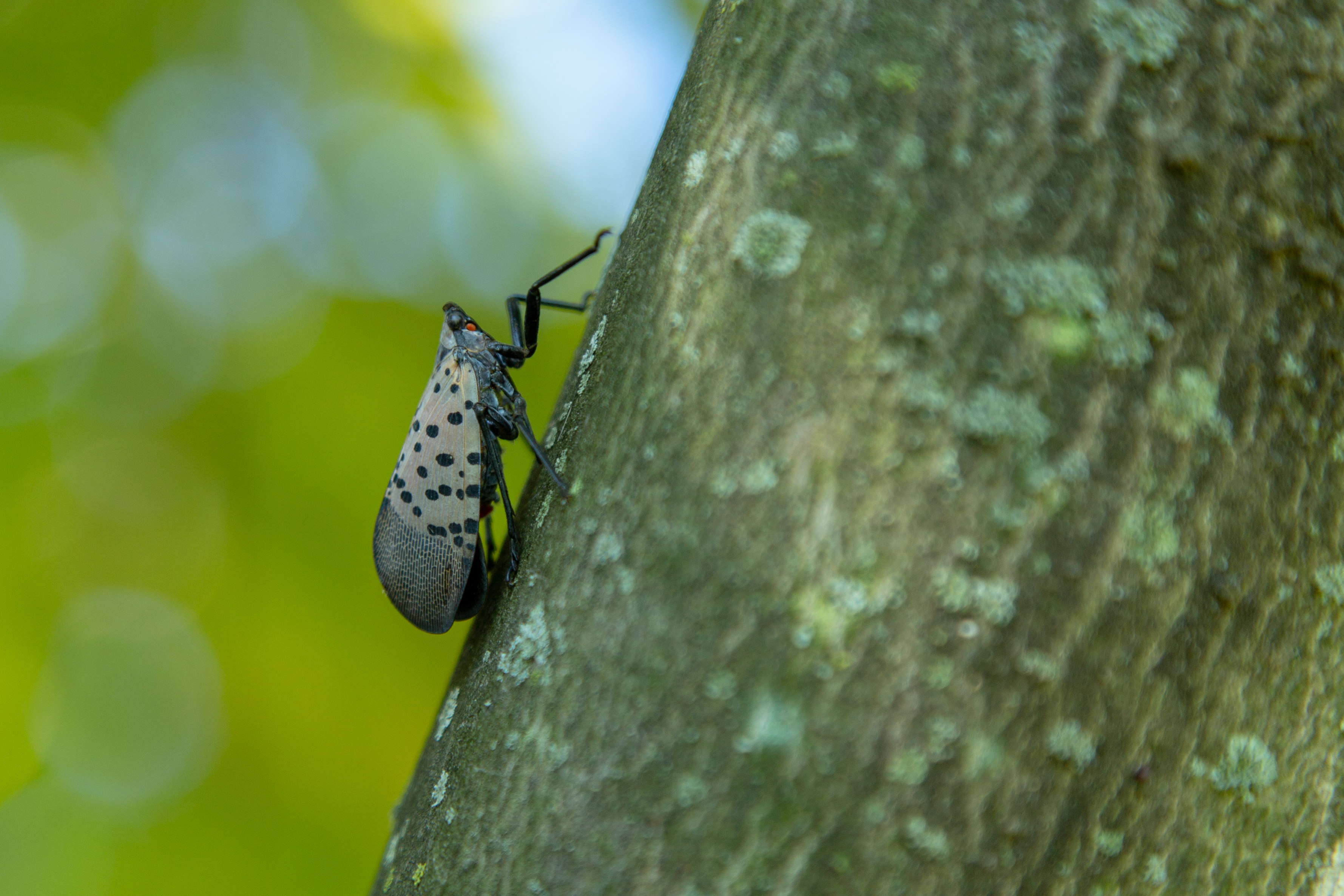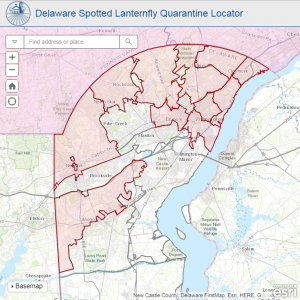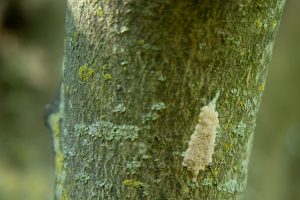Emergency quarantine declared for pest threatening Delaware
Department of Agriculture | News | Date Posted: Friday, March 1, 2019
Department of Agriculture | News | Date Posted: Friday, March 1, 2019

Photos are available for media use on Flickr.
Dover, Del. – The Delaware Department of Agriculture (DDA) announced today that they are quarantining eleven zip codes in New Castle County to eradicate, control, and prevent the spread of spotted lanternfly in Delaware and to surrounding states.
The spotted lanternfly is a destructive invasive plant hopper that attacks many hosts including trees, shrubs, orchards, grapes, and hops. The insect is detrimental to Delaware’s agricultural industry, forests, and residential areas. Due to quarantines in other states, interstate commerce will be impacted if the pest is transported out of the Delaware quarantine area.
“We understand this quarantine will impact businesses and homeowners; however, it is required if we have any chance to control this non-native, destructive pest. With the hatching of egg masses and the presence of adult lanternflies, the population has grown and requires treatment and control efforts,” said Secretary of Agriculture Michael T. Scuse. “The impact of this pest to Delaware is large with 8 billion dollars of Delaware’s economic activity related to agriculture. When you look at our orchards and vineyards, nursery and landscaping industry, and forestland and timber sales, you are looking at more than 1.9 billion dollars alone. Delaware has a lot to lose if we do not gain control over the spotted lanternfly.”

The following zip codes in New Castle County have been quarantined in their entirety: 19702, 19703, 19707, 19711, 19801, 19802, 19803, 19805, 19807, 19809, and 19810. The quarantine can expand if there is reason to believe that the pest has moved to a non-quarantined area. A quarantine means that any material or object that could harbor the pest cannot be moved without taking precautions to prevent the spread.
The female spotted lanternfly lays egg masses of 30 to 50 eggs wherever it chooses, especially on flat surfaces. All other life stages of this insect from nymphs to adults can fly, hop, or drop onto a vehicle – meaning that this pest can easily be transported to new areas where it can create another infestation.
Examples of regulated articles include:
In order to move regulated items, the general public will need to complete a residential compliance checklist indicating that you inspected and know that no living life stage of the spotted lanternfly is present on the articles. The checklist is available online at https://de.gov/hitchhikerbug.

“We have the advantage right now that spotted lanternfly nymphs will not hatch until April and May. We are asking residents to go to our website and download a copy of the compliance checklist,” said DDA Plant Industries Administrator Jessica Inhof. “Then take the time to check all the items you have on the list for egg masses. If you find them, scrape them off into a bag filled with alcohol or an alcohol-based hand sanitizer and crush them to destroy the eggs. You will help Delaware to reduce the potential damage that these pests could inflict this spring and summer.”
Any person conducting business for a commercial business, municipalities, or a government agency that requires movement of any regulated item within or from the quarantine area must have a permit, available through the DDA spotted lanternfly website. To obtain a permit, a designated individual from an organization must receive training and pass an online test to demonstrate a working knowledge and understanding of the pest and quarantine requirements. Training of other employees, inspection of vehicle and products, and removal of living stages of spotted lanternfly must be completed. The permit demonstrates the individual understands how to identify the pest and can ensure the items transported are not carrying the insect.
For more detailed information regarding the emergency quarantine, permitting, treatment, or to report a sighting of spotted lanternfly, visit the Delaware Department of Agriculture’s dedicated spotted lanternfly webpage at https://de.gov/hitchhikerbug or call the dedicated spotted lanternfly hotline at (302) 698-4632. When leaving a message, leave your contact information and, if reporting a sighting, please provide the location of the sighting.
The initial Delaware detection of spotted lanternfly was in Wilmington in the fall of 2017. In 2018, DDA Plant Industries inspectors along with USDA staff conducted surveys around the area where the initial detection was found. The surveys demonstrated that spotted lanternfly had multiple established populations in northern New Castle County.
###
Media Contact: Stacey Hofmann, (302) 698-4542, Stacey.Hofmann@delaware.gov
Related Topics: Delaware Department of Agriculture, Delaware Secretary of Agriculture Michael T. Scuse, egg mass, emergency quarantine, New Castle County, Permit, pest, Plant Industries Section, quarantine, residential compliance checklist, spotted lanternfly
Keep up to date by receiving a daily digest email, around noon, of current news release posts from state agencies on news.delaware.gov.
Here you can subscribe to future news updates.
Department of Agriculture | News | Date Posted: Friday, March 1, 2019

Photos are available for media use on Flickr.
Dover, Del. – The Delaware Department of Agriculture (DDA) announced today that they are quarantining eleven zip codes in New Castle County to eradicate, control, and prevent the spread of spotted lanternfly in Delaware and to surrounding states.
The spotted lanternfly is a destructive invasive plant hopper that attacks many hosts including trees, shrubs, orchards, grapes, and hops. The insect is detrimental to Delaware’s agricultural industry, forests, and residential areas. Due to quarantines in other states, interstate commerce will be impacted if the pest is transported out of the Delaware quarantine area.
“We understand this quarantine will impact businesses and homeowners; however, it is required if we have any chance to control this non-native, destructive pest. With the hatching of egg masses and the presence of adult lanternflies, the population has grown and requires treatment and control efforts,” said Secretary of Agriculture Michael T. Scuse. “The impact of this pest to Delaware is large with 8 billion dollars of Delaware’s economic activity related to agriculture. When you look at our orchards and vineyards, nursery and landscaping industry, and forestland and timber sales, you are looking at more than 1.9 billion dollars alone. Delaware has a lot to lose if we do not gain control over the spotted lanternfly.”

The following zip codes in New Castle County have been quarantined in their entirety: 19702, 19703, 19707, 19711, 19801, 19802, 19803, 19805, 19807, 19809, and 19810. The quarantine can expand if there is reason to believe that the pest has moved to a non-quarantined area. A quarantine means that any material or object that could harbor the pest cannot be moved without taking precautions to prevent the spread.
The female spotted lanternfly lays egg masses of 30 to 50 eggs wherever it chooses, especially on flat surfaces. All other life stages of this insect from nymphs to adults can fly, hop, or drop onto a vehicle – meaning that this pest can easily be transported to new areas where it can create another infestation.
Examples of regulated articles include:
In order to move regulated items, the general public will need to complete a residential compliance checklist indicating that you inspected and know that no living life stage of the spotted lanternfly is present on the articles. The checklist is available online at https://de.gov/hitchhikerbug.

“We have the advantage right now that spotted lanternfly nymphs will not hatch until April and May. We are asking residents to go to our website and download a copy of the compliance checklist,” said DDA Plant Industries Administrator Jessica Inhof. “Then take the time to check all the items you have on the list for egg masses. If you find them, scrape them off into a bag filled with alcohol or an alcohol-based hand sanitizer and crush them to destroy the eggs. You will help Delaware to reduce the potential damage that these pests could inflict this spring and summer.”
Any person conducting business for a commercial business, municipalities, or a government agency that requires movement of any regulated item within or from the quarantine area must have a permit, available through the DDA spotted lanternfly website. To obtain a permit, a designated individual from an organization must receive training and pass an online test to demonstrate a working knowledge and understanding of the pest and quarantine requirements. Training of other employees, inspection of vehicle and products, and removal of living stages of spotted lanternfly must be completed. The permit demonstrates the individual understands how to identify the pest and can ensure the items transported are not carrying the insect.
For more detailed information regarding the emergency quarantine, permitting, treatment, or to report a sighting of spotted lanternfly, visit the Delaware Department of Agriculture’s dedicated spotted lanternfly webpage at https://de.gov/hitchhikerbug or call the dedicated spotted lanternfly hotline at (302) 698-4632. When leaving a message, leave your contact information and, if reporting a sighting, please provide the location of the sighting.
The initial Delaware detection of spotted lanternfly was in Wilmington in the fall of 2017. In 2018, DDA Plant Industries inspectors along with USDA staff conducted surveys around the area where the initial detection was found. The surveys demonstrated that spotted lanternfly had multiple established populations in northern New Castle County.
###
Media Contact: Stacey Hofmann, (302) 698-4542, Stacey.Hofmann@delaware.gov
Related Topics: Delaware Department of Agriculture, Delaware Secretary of Agriculture Michael T. Scuse, egg mass, emergency quarantine, New Castle County, Permit, pest, Plant Industries Section, quarantine, residential compliance checklist, spotted lanternfly
Keep up to date by receiving a daily digest email, around noon, of current news release posts from state agencies on news.delaware.gov.
Here you can subscribe to future news updates.